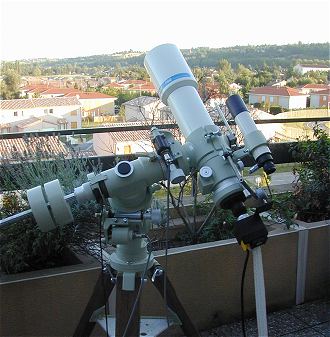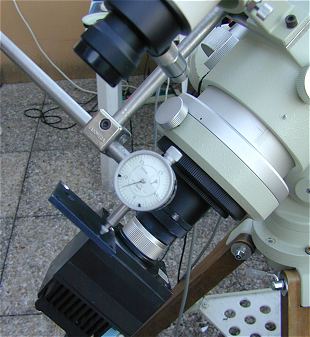

Above: My suburban observatory and my streetlight !
Suburban hydrogen Halpha imagery
This page contains hydrogen-alpha filtered
CCD
images of nebulae taken
from my light-polluted backyard in Castanet-Tolosan (near Toulouse, South of
France).
A H-Alpha filter transmits light centered on a wavelength of 656.3 nm. The bandpass of my filter is around 10 nm. A narrowband filters of this type transmit the light emitted by nebulae, but light from artificial sources like street lights is blocked. It is a big advantage for me... see below my observatory localisation !


Above: My suburban observatory and
my streetlight !
To take my images I used a Takahashi FSQ-106 refractor (106 mm F/D=5) and an Audine CCD camera (KAF-1602E chip - 2x2 bin). The H-Alpha filter is a 10 nm band-pass from Edmund (24 mm diameter - ref. NT43-138). You can get this filter directly from Edmund Industrial Optics (http://www.edmundoptics.com). I use Pisco for image acquisition and Iris for processing. The images were composed of stack of numerous unguided 1-5 minute exposures (Takahashi NJP platform).
I have controlled the filter myself (see http://astrosurf.com/buil/us/filter/filter.htm). It is conform to the specification (50% transmission at the H-Alpha wavelength). For information about the spectral composition of my sky background, click here.


Above: The instrument. The F/D ratio
of the refractor is
5, so precise focusing is essentiel for good images (note the micrometer). The
focus tolerance d is given by the formula d=2.2 x (F/D)2.
For my setup, d value is only 50 microns. Another consideration: placing the filter in the optical
beam shift the focus plane by the quantity e . (n-1) / n, where e
is the filter thickness and n
is the index of refraction of the filter glass (n=1.5 is typical). The thickness of the Edmund
filter is of 4.6 mm, so the focal plane is shifted by 1.5 mm.
FSQ-106 images are undersampled (binning
2x2 during the acquisition, i.e. 18 microns pixel for the CCD). Click on
the bin. 2x2 images below to display enlarged and better resolution
frame versions by the use of a dithering method (scaling of 1.5).
Click
here for details.

Above:
IC1805 complex. Exposure: 75 minutes total (20 frames of 2 minutes each + 7
frames of 5 minutes each). Date: 15.1/08/2002.

Above: An image of NGC 7000 (south
of America
nebula). It is the combination of 32, one-minute exposures.

Above:
Negative view of IC1396 (VDB142 region). Exposure: stack of 21 x 2 minutes frames
(total: 42 minutes).

Above:
Part of California nebula (NGC 1499). Exposure: 55 minutes total (11 frames of 5 minutes).

Above:
Pelican nebula (part of NGC 7000). Same procedure as above but the refractor
is now an
AstroPhysics
STAR 120 ED (120-mm aperture - F/D=8.5).
Exposure: 90 minutes total (30 frames of 3 minutes each).
Click on the image
for an enlarged more resolved section of the image (drizzling processing).
Only the 17 best
resolved frame are selected for this. Date: 15.94/08/2002.